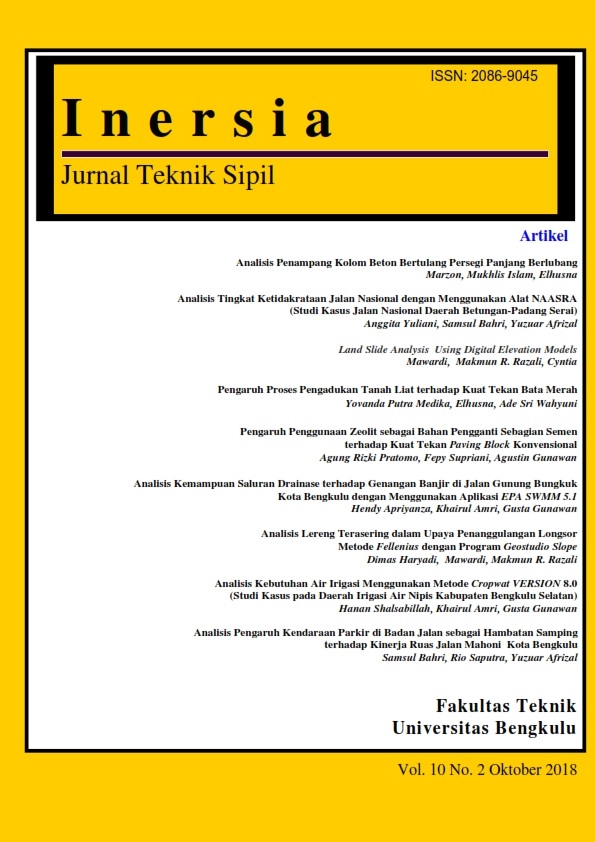Main Article Content
Abstract
Landslides almost every year occur in Indonesia, this rare landslide that can be detected early. because so far the prediction of slope slope is difficult. To predict the calculation requires the analysis and stability of the slope manually. This manual calculation process is quite long and long process. The calculation data and slope stability analysis are in the form of slope measurement, the work is quite tiring and risky for the researcher, and also the scope of the slope that can be measured is only narrow. In addition to slope inclination data, for slope analysis also requires soil data to be sampled and testing in a geotechnical laboratory. This study investigated slope stability by creating landslide models using Digital Elevation Models (DEM), and Geoslope programs. Slope model was analyzed from DEM and landslide stability analysis using Geoslope. From this concept we are expected to analyze landslide / stability slope quickly and accurately without risk for researcher. The results of lab tests were obtained:
water content (wN), wN1 = 39.47%, wN1 = 40.54%, wN1 = 38.89%. Specific Soil Weight (Gs) ranged from 2.60 to 2.62, wet soil volume weight ranged from 14.59 to 16.16 kN / m3, the weight of saturated soil volume ranged from 15.59 to 16.82 kN / m3, the weight of soil volume dried ranged from 09.99 to 16.82 kN / m3, soil liquid limit ranged 61.26-66.06%, plastic limit of land ranged from 39.58 to 44.88%, soil plastic index ranged from 21.18 to 21.66, so that the soil is categorized as organic clay soil, the face of the soil at a depth of -0.5m, the cohesion value (c) ranges from 29.10 to 34.90 kPa, and the frictional angle values in the range 19.51 21.100, the slope of the slope ranges from 24 to 420 and slope safety figures (FK), on slopes 1 FK = 1.87 (slope safe against landslide hazard), on slope 2 FK = 1.20 (slope unsafe against landslide hazard), on slope 3 FK = 1.52 (the slope is safe from landslide hazards).
Article Details
Authors who publish with this journal agree to the following terms:
- Authors retain copyright and grant the journal right of first publication with the work simultaneously licensed under a Creative Commons Attribution License that allows others to share the work with an acknowledgment of the work's authorship and initial publication in this journal.
- Authors are able to enter into separate, additional contractual arrangements for the non-exclusive distribution of the journal's published version of the work (e.g., post it to an institutional repository or publish it in a book), with an acknowledgment of its initial publication in this journal.
- Authors are permitted and encouraged to post their work online (e.g., in institutional repositories or on their website) prior to and during the submission process, as it can lead to productive exchanges, as well as earlier and greater citation of published work (See The Effect of Open Access).
- This work is licensed under a Creative Commons Attribution-ShareAlike 4.0 International License.
References
- Budi, G.S., 2011, Pengujian Tanah di Laboratorium, Graha Ilmu,
- Yogyakarta.
- Das, B.M. 1994. Mekanika Tanah (Prinsip-Prinsip Rekayasa Geoteknis)Jilid II, Erlangga, Jakarta.
- Hardiyatmo, H.C., 2002, Mekanika Tanah I, Gadjah Mada University Press,
- Yogyakarta.
- Hardiyatmo, H.C., 2010, Stabilisasi Tanah untuk Perkerasan Jalan, Gadjah Mada Universi3ty Press, Yogyakarta.
- SNI-03-3438-1994, 1994, Tata Cara Pembuatan Rencana Stabilisasi Tanah dengan Semen Portland untuk Jalan, Pusjatan Balitbang PU.
- SNI-03-1968-1990, 1990, Metode Pengujian Tentang Analisis Saringan
- Agregat Halus dan Kasar, Pusjatan Balitbang PU.
- SNI-03-1744-1089, Metode Pengujian CBR Laboratorium, Pusjatan Balitbang PU.
- SNI-1742-2008, 2008, Cara Uji Kepadatan Ringan untuk Tanah, Badan Standardisasi Nasional.
- SK-SNI-3423-1994, Cara Uji Analisis Ukuran Butir Tanah, Badan
- Standardisasi Nasional.
- SNI-1964-2008, 2008, Cara Uji Berat Jenis Tanah, Badan Standardisasi
- Nasional.
- SNI-1965-2008, 2008, Cara Uji Penentuan Kadar Air Untuk Tanah dan Batuan di Laboratorium, Badan Standardisasi Nasional.
- SNI-1966-2008, 2008, Cara Uji Batas Plastis dan Indeks Plastisitas Tanah,
- Badan Standardisasi Nasional.
- SNI-1967-2008, 2008, Cara Uji Batas Cair Tanah, Badan Standardisasi Nasional.
- SK-SNI-1967-1990, 1990, Cara Uji Penentuan Batas Cair dengan Alat
- Cassagrande, Badan Standardisasi Nasional.
- SK-SNI-2813-2008, 2008 Cara pengujian Kuat geser tanah, Badan Standardisasi Nasional.
- SK-SNI 03-3637-1994, 1994, Cara pengujian berat isi, Badan Standardisasi Nasional.
References
Budi, G.S., 2011, Pengujian Tanah di Laboratorium, Graha Ilmu,
Yogyakarta.
Das, B.M. 1994. Mekanika Tanah (Prinsip-Prinsip Rekayasa Geoteknis)Jilid II, Erlangga, Jakarta.
Hardiyatmo, H.C., 2002, Mekanika Tanah I, Gadjah Mada University Press,
Yogyakarta.
Hardiyatmo, H.C., 2010, Stabilisasi Tanah untuk Perkerasan Jalan, Gadjah Mada Universi3ty Press, Yogyakarta.
SNI-03-3438-1994, 1994, Tata Cara Pembuatan Rencana Stabilisasi Tanah dengan Semen Portland untuk Jalan, Pusjatan Balitbang PU.
SNI-03-1968-1990, 1990, Metode Pengujian Tentang Analisis Saringan
Agregat Halus dan Kasar, Pusjatan Balitbang PU.
SNI-03-1744-1089, Metode Pengujian CBR Laboratorium, Pusjatan Balitbang PU.
SNI-1742-2008, 2008, Cara Uji Kepadatan Ringan untuk Tanah, Badan Standardisasi Nasional.
SK-SNI-3423-1994, Cara Uji Analisis Ukuran Butir Tanah, Badan
Standardisasi Nasional.
SNI-1964-2008, 2008, Cara Uji Berat Jenis Tanah, Badan Standardisasi
Nasional.
SNI-1965-2008, 2008, Cara Uji Penentuan Kadar Air Untuk Tanah dan Batuan di Laboratorium, Badan Standardisasi Nasional.
SNI-1966-2008, 2008, Cara Uji Batas Plastis dan Indeks Plastisitas Tanah,
Badan Standardisasi Nasional.
SNI-1967-2008, 2008, Cara Uji Batas Cair Tanah, Badan Standardisasi Nasional.
SK-SNI-1967-1990, 1990, Cara Uji Penentuan Batas Cair dengan Alat
Cassagrande, Badan Standardisasi Nasional.
SK-SNI-2813-2008, 2008 Cara pengujian Kuat geser tanah, Badan Standardisasi Nasional.
SK-SNI 03-3637-1994, 1994, Cara pengujian berat isi, Badan Standardisasi Nasional.
